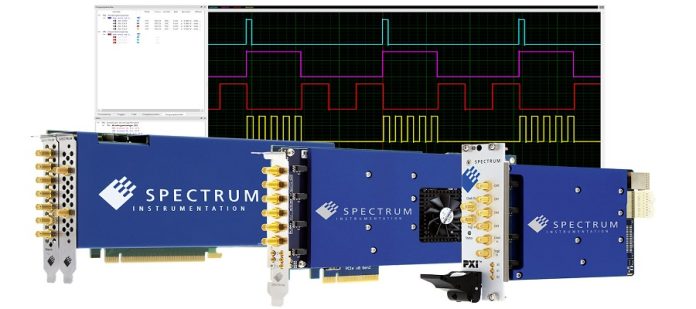After the successful introduction of the Digital Pulse Generator (DPG) option for its medium-speed products, Spectrum Instrumentation has now added the same feature to its ultrafast digitizers (with up to 10 GS/s speed) and Arbitrary Waveform Generators. Available for the entire product line, the low-cost option adds three to four independent digital sources for generating pulses and pulse streams. This new capability makes them ideal for a wide variety of automated test and measurement applications. For example, the DPG option can be added to 200+ products so that they can produce the stimulus and trigger signals needed for machine or experiment control in systems deploying AI, robotics and mechatronics, for closed-loop testing, or even when assessing electronic circuits, components and sensors.
With the DPG option installed, the Digitizer and AWG products can produce digital pulses with a timing resolution that is based on the sampling clock of the device. For instance, the DPG together with one of the company’s flagship 33xx series digitizers can produce up to four separate pulse streams, each with timing resolution down to just 3.2 ns. At the same time, the 12-bit digitizer card can acquire incoming electronic signals by sampling them at rates up to 10 GS/s!
The DPG is implemented using the on-board FPGA technology of the product. The design allows the units to perform their regular tasks of acquiring or generating analogue waveforms in parallel with pulse generation. The digital pulses are output via front panel Multi-Purpose I/O connectors and are suitable for use with today’s most common digital circuitry. The pulse amplitude levels are 3.3 V low voltage TTL (LVTTL); TTL is compatible for high impedance loads.
Control of the DPG is via a simple programming structure that allows adjustment of the pulse characteristics, whether it is generating single pulses, pulse trains or continuous pulse streams. Key parameters, such as the pulse width, period, phase, or the number of pulses in a pulse train, are all programmable. Once enabled, the DPG will output the pre-programmed pulses on the assigned Multi-Purpose I/O connector as soon as it receives a valid trigger. For maximum flexibility, the trigger can be generated by software, or from one of many different possible sources. These include all the product’s regular internal and external trigger sources or even one of the other DPG channels. As the pulse generator outputs are intrinsically synchronized to the product’s acquisition or replay functionality, they are perfect for producing enabling or switching signals (e.g. for signal actuating). Furthermore, the ability to cascade the different pulse generators creates a convenient way to transform pulse repetition time scales.








